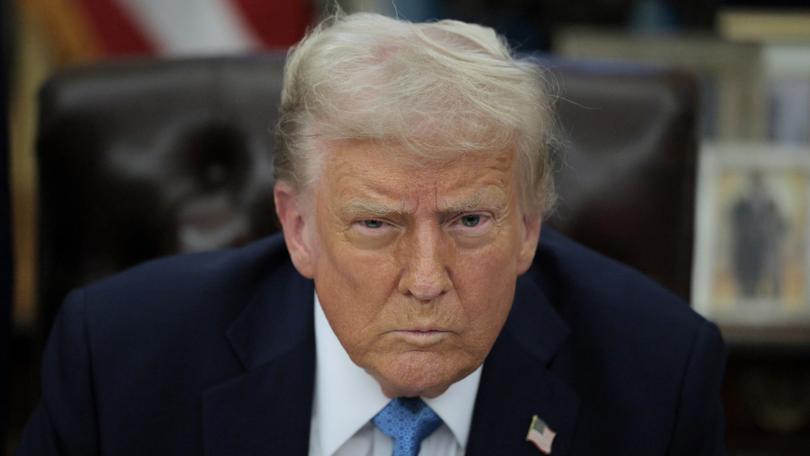THE ECONOMIST: How Donald Trump’s tariff turbulence will cause economic pain

Donald Trump took North America to the precipice of a trade war over the weekend. On February 3 he cooled things down, delaying tariffs on Canada and Mexico by a month as the countries attempt to reach a deal that may involve everything from immigration controls to trade concerns.
The sudden about-turn underscored Mr Trump’s reputation as an agent of chaos who uses extreme threats to wrest concessions out of others. It is a dangerous game that can just as easily lead to miscalculations and corrosive uncertainty for the global economy.
Mr Trump’s mood had been both euphoric and combative, even by his standards, after announcing tariffs on America’s three biggest trading partners — Mexico, Canada and China — over the weekend. “THIS WILL BE THE GOLDEN AGE OF AMERICA!” he posted on Truth Social, his social-media platform. “IT WILL ALL BE WORTH THE PRICE THAT MUST BE PAID.”
Sign up to The Nightly's newsletters.
Get the first look at the digital newspaper, curated daily stories and breaking headlines delivered to your inbox.
By continuing you agree to our Terms and Privacy Policy.On February 3 global markets offered a glimpse of that price: stocks fell throughout the world, oil prices rose and most currencies weakened against the dollar. But as soon as Mr Trump relented — first announcing the delay in the tariffs on Mexican imports and then, a few hours later, on Canadian goods — the market moves went into reverse. Now you see the damage; now you don’t.
As welcome as the de-escalation is, it sets up a worrying paradox for markets in the months to come. A compelling theory of Mr Trump is that while he pays scant regard to the opinions of economists, of lawyers and of other politicians, investors do have sway over him. He does not want to prompt a stock market rout.
That is why some observers assumed that his tariffs of 25 per cent on goods from Canada and Mexico were always going to be short-lived. Such an assumption was validated by his abrupt reversal. It may, therefore, end up limiting sell-offs during any future trade disputes, which in turn could allow Mr Trump to stick to his protectionist guns for longer.
The dynamic could soon be put to the test. For starters, Mr Trump has kept the spectre of tariffs hanging over both Canada and Mexico: Mr Trump has merely delayed them by a month, not taken them off the table. One basic challenge for the countries’ officials is to work out what exactly it is that Mr Trump wants.
His executive orders announcing the levies had described them as an emergency response to the flow of drugs and illegal immigrants into America. In subsequent comments, he emphasised economic goals. So long as companies made their products in America, they would not face tariffs, he said. He also repeated his fallacious claim that by running trade deficits, America is subsidising other countries.
For the moment both Claudia Sheinbaum, Mexico’s president, and Justin Trudeau, Canada’s prime minister, have bought time by appealing to Mr Trump’s security preoccupations. Ms Sheinbaum agreed to deploy 10,000 soldiers to her country’s northern border to help stem the flow of fentanyl into America. Mr Trudeau said the Canadian government would strengthen its border controls, including by launching a new joint strike force with America to stop fentanyl trafficking. Sceptics noted that such measures were largely reiterations of the two countries’ existing policies to crack down on the cross-border drug trade.
The tariffs on Canada and Mexico may, in any case, just be a curtain-raiser for Mr Trump’s protectionist programme. Over the weekend he announced extra tariffs of 10 per cent on all imports from China. So far he has yet to offer America’s geopolitical rival a reprieve. He has also said in recent days that he would “absolutely” implement tariffs on the European Union and has pledged to slap levies of as much as 100 per cent on semiconductors made in Taiwan. These actions may all feed into a grander vision of introducing a universal tariff on all imports, which he repeatedly promised on the campaign trail, believing that it would usher in a manufacturing renaissance in America.
In fact, even tariffs on just Canada and Mexico would do serious harm to American manufacturing. That is especially true for American carmakers, who, encouraged by decades of free-trade deals, have come to rely on factories in Canada and Mexico. A 25 per cent tariff would have wiped out the profits of the “big three” automakers in Detroit — Stellantis, General Motors and Ford — if the firms took no action to raise prices or alter production, according to Barclays, a bank.
The impact might well have been much greater than a simple 25 per cent surcharge on vehicles and parts made in Canada or Mexico would suggest. Some vehicles cross America’s borders up to seven times as components are assembled into bigger units before being despatched to car firms for final assembly. There was no mechanism that would have prevented these products from being hit with tariffs each time they crossed the border, says Robert Asselin of the Business Council of Canada.
To the extent that companies could prepare by building up inventories or finding alternative suppliers, they did. “The problem is math. Price becomes a choke point. When something is not viable anymore, it just breaks down,” says Mr Asselin. Rumour had it that factories in Detroit could send workers home by the end of the week. Smaller suppliers without the capital to cover higher costs might have stopped producing parts, making it impossible for the production of certain vehicles to continue. Some suppliers could even have gone bust.
Mr Trump’s unconsummated threats will generate huge uncertainty for businesses in America and beyond. Markets may well be correct to downplay future announcements by Mr Trump. But corporate managers do not have the same luxury when making decisions about how to allocate capital in the years to come.
Few will dare to scale up investments in Canada or Mexico while Mr Trump is in the White House. At the same time, apart from making splashy announcements to please the president, they may also be reluctant to launch big projects in America without clarity about whether they can count on unfettered access to global supply chains and export markets.
The economic literature has long identified uncertainty as an impediment to investment and growth. In one highly pertinent example, a discussion paper for the Federal Reserve found that trade-policy uncertainty during Mr Trump’s first term — then mainly focused on China — reduced investment in America in 2018 alone by at least 1 per cent.
This time, Mr Trump’s mooted tariffs cover both far more of the world and a far larger slice of America’s industrial landscape. Whether he follows through on his threats or not, he has already succeeded in stirring up an immense amount of confusion and anxiety for firms. If he continues down this path, the consequences for the global economy will be grave.
